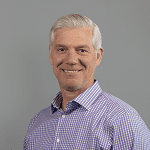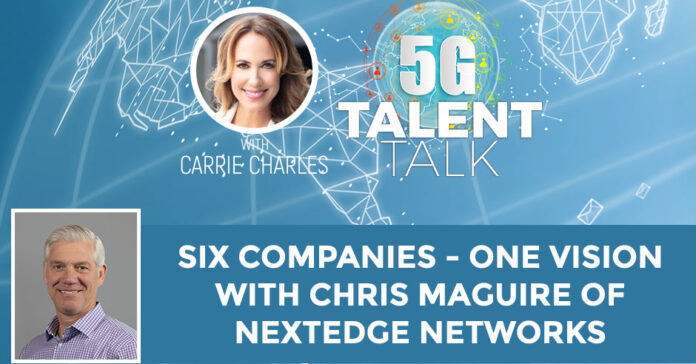How do you effectively bring six solution-oriented companies under one umbrella? The answer is clear: a shared vision. In this week’s episode, discover how Chris Maguire found one vision and managed to diversify with NextEdge Networks. Join your host Carrie Charles as she talks to its CEO, Chris. With NextEdge, Chris has built a nationwide, turn-key smart community infrastructure firm. Listen to learn about the roll-up strategy, how he attracts and keeps talent, charging stations, and more.
—
Watch the episode here
Listen to the podcast here
Six Companies – One Vision with Chris Maguire of NextEdge Networks
The Global Smart Cities Market is projected to reach $2.5 trillion by 2026. There are many companies who’ve been organizing their efforts to take advantage of this growth and all the business opportunities that come with this. We’re going to talk to one company that has built a nationwide turn-key, smart community infrastructure firm. I have with me, the man at the helm of this vision, Chris Maguire, the CEO of NextEdge Networks. Chris, thanks so much for being on the show today.
Thanks for having me, Carrie. I appreciate it.
I love to know how you got from where you were to where you are now, a little bit about the twists and turns of your career path.
It certainly hasn’t been a direct line to where I am. I came out of college as an Accounting and Finance major. I went directly to work for Ernst & Young in Washington, DC, right out of school. I determined fast that accounting was not what I wanted to do with the rest of my life. I quickly transitioned out of that group to positions inside that did things like transactional advisory services, investment banking and M&A-type roles. I ended up at a very young age participating in a few IPO’s. I raised a lot of capital. I completed a lot of M&A transactions for a bunch of different companies. I found that I liked that strategy side of the business much more than back-office sitting at a desk everyday world.
What I liked about it, it allowed me to see the entire organization and see how it all worked together. What was successful, what wasn’t and how organizations were built and developed. I got into telecom where I am now in a strange way and timing and a little luck or everything, as they say. I spent time in radio and television in the early 1990s prior to getting into telecom. We merged our radio company with Steve Dodge’s American Radio Systems. It created the second-largest radio company in the country.
In about the mid-1990s, we were selling ARS to CBS. We’re starting to receive a lot of strange phone calls from companies like McCaw Cellular, Bell Atlantic NYNEX Mobile, to see if they could rent tower space on our broadcast towers. We didn’t know for what. Steve being the guy he was, had a lot of vision. He had a lot of questions. He did a lot of research and came to the conclusion that wireless was going to be the next big thing.
Prior to selling the stations, all the towers got put into a subsidiary called American Radio Systems. It was kept separate from the radio transaction and was the launch of what’s now American Tower Corporation. It came out of nowhere and a whole bunch of acquisitions and mergers later, and we’ve all seen with our companies become. It was impressive to see how that group developed.
Since American Tower, I have done a lot of things in and around telecom, some smaller tower companies, mostly on the infrastructure side, going back into broadcasting here and there. I’ve also done some things on renewables, which are very similar to the tower business with some more complicated financial pieces to it, but a lot of similarities. That’s what I’ve been doing.
Diversify your business from a customer standpoint and from a service offering standpoint.
You were on the finance side of broadcasting, but you do have the voice for it too, in case you want to have another career in your future. Tell me about the story behind NextEdge Networks. How was it born? What’s the structure and the companies that are underneath your umbrella?
NextEdge now looks very different from what its original intended purpose was. Coming from the infrastructure side of the world, I was working with some private investors to figure out a place in a niche in the telecom world that we could invest in. We’re used to recurring revenue tower-type businesses. We’d spend a lot of time interviewing a lot of large real estate owners at the time who was constantly talking about the lack of coverage in their buildings. The fact that all the lead-certified stuff was blocking signals, getting into the buildings, they were losing tenants and it was becoming a big problem for them.
We started looking into that business. Timing is everything and our timing wasn’t great because right about the time we were doing that was when the carriers decided that they weren’t going to pay for building access anymore. In the big venues, the football stadiums and stuff, they would, but your 250,000 square foot commercial office space, they weren’t going to do it anymore. It was too expensive.
The landlords had a problem, but they didn’t want to pay for it either. We found ourselves being in a business that had a need. There was a solution, but there was nobody wanted to pay for it. It seems like that industry is still a little lumpy. There are people that are doing well in it. We couldn’t figure out a way to do well in it, so we quickly had to pivot. Given all the trends around wireless that we’d seen, the projected CapEx spends that were coming from the various customers in this business, we knew that there was a great opportunity in telecom and we wanted to hover around it.
The infrastructure pricing was high and it still is. We focused on the services sector and it sounds like a real paradigm shift for what we’re trying to do, but it’s natural. Historically, all of our infrastructure businesses started out as services companies. We’ve always viewed services businesses as the business development and information access arm of the telecom world.
They knew what was going on early when networks were being developed. They know what directions and markets people are working in. We went out and acquired a small group of recurring revenue contracts from a data center company called EdgeConneX that launched our business back in 2016. The revenue and cashflows from those contracts allowed us to see the business and go out and keep trying to grow the world.
About early to mid-2017, we found a business in San Francisco. It was a small cell services business called Modus. I knew some of the principals there. They were looking to grow. They had a great demand for their product. They needed capital and some more management horsepower to help them harness all that growth. We acquired them in June 2017 and we spent the next few years building that business organically, growing into new markets and working with new customers.

After growing that, we came to the conclusion that we needed to do some things to diversify the business. Several months ago, in the middle of 2021, we also merged in two companies, a company called Spectrum Services in Las Vegas, and then a business called Tachyon out of Atlanta, which had four operating companies under it that all came under the NextEdge umbrella.
All these transactions allowed us to diversify our business geographically from a customer standpoint, as well as from services offering standpoint. We have a full suite of services coast to coast. We are six operating companies strong under the NextEdge umbrella. We’ve doubled our size from revenue as well as a human capital standpoint. We’ve got 600 in-house people doing this work with the ability to deliver the end-to-end services that we want from coast to coast.
I wrote down the companies that are part of NextEdge, Summitt Cellular, Towersource, Source Broadband, NIS, Spectrum Services and last but not least Modus, the first one. Out of these six companies, what role does each have? You talked a little bit about Modus and maybe one other, but briefly what role does each have in the 5G ecosystem?
It’s important to note that each of these companies has been around for many years. They’ve done 1G, 2G, 3G, 4G and now we have our place in the 5G network. The only reason they exist in this 5G world is that they’ve demonstrated their ability to execute and meet their customer’s needs in those previous network build-outs.
As a whole, we can participate in about every piece of the 5G ecosystem. We have what we call managed services which are the upfront work like site selection, design, site acquisition, zoning, permitting, and all that stuff. We’ve got the ability to do the backend work, construction, installation, modifications, integration, optimization, maintenance and we can do it for small cells. We can do for macros, DAS, rooftops and Greenfield towers, you name it.
We have these capabilities in all the geographies we work with, which are East Coast to the West Coast. Through Source Broadband, we have the ability to do aerial and underground fiber construction and splicing. Although that skillset isn’t a national skillset now, it’s focused in the Southeast. With the six operating companies we have, we’ll start it on the east, NIS, which is Network Installation Specialists, and Summit Cellular are similar companies in terms of the service offerings.
They’re primarily backend service companies. They can do macro, small cell construction installation, integration, optimization, as well as participating in emergency services response and things like that. Those are focused in the Southeast. They perform in different geographies, but they’re in that same region.
Towersource is a frontend managed services business. They handle all the site ag zoning and things like that in the Southeast. Source Broadband, as I mentioned, does the fiber construction and mostly in the Tennessee market. Spectrum Services and Modus in the West, which is Texas West, are more fully integrated businesses. They do both, the managed services as well as the backend work. Modus’ geography is more West Coast, whereas Spectrum Services is more of the desert Southwest.
People in the carrier industry are not there to do a job. They’re there to figure things out.
I’m sure that there are a lot of things you’d like to do, but you don’t have enough people and that’s what everybody’s dealing with now. Is there any commonality between the companies, let’s say, shared values or similar cultures?
That was a big component of this. We didn’t go out to roll up a bunch of people and see what happens. It was about finding the right fit. We wanted to diversify our businesses. We would have preferred to do it organically or at least that’s what we thought. Bringing Spectrum and the Tachyon companies in-house was a natural fit for us. We talked to a lot of people.
Every time things weren’t going to work out, it was all about the people and the culture side of it. These businesses fit what we were all trying to do, and quite frankly, we fit where they were trying to do in their process as well, but in terms of similar characteristics, almost every one of these businesses is still run by their founders.
These founders still are going forward, having a meaningful investment in these businesses in the future of their companies. They’ve all been around for a long time in this industry with sterling reputations. You don’t find that everywhere. There were a lot of people in and out of this business. These guys have been here forever and you’re only here if you perform.
More importantly, there was a couple of cultural things. They were all hyper-focused on quality and delivering for their customers. We heard that time and time again when we talked to these companies. They’re highly competitive and got a huge desire to win and that is from the top to the bottom. They’re very creative. When I say creative, they focus on solutions. They’re not there to do a job. They’re there to figure things out.
One of the commonalities with these companies is in almost every one of these jurisdictions, they get assigned the hardest work, which is a testament to what the carrier community thinks of them. The other part is they each had a principled culture, their desire to be a place that attracts the best people. They brought people in and train people the way we think about it. We have a huge preference for bringing new people into this industry versus trying to find seasoned people. We find that works much better for us. Those are the common characteristics.
There are challenges with a roll-up strategy and you’ve done some things well here. What are some of those things that you say, “This worked and this is a rinse and repeat?”

Roll-ups are risky. I don’t think we ever went out there thinking we were going to do roll-ups, but these roll-ups in our mind as we were looking at it de-risked our business and helped us diversify quickly. When it was just Modus, we spent a few years growing the business organically, and we were doing well, but as that process was moving along, it became apparent to us that we were relying on 1 geography, 1 or 2 customers and doing 1 or 2 things well. We set up to diversify the business, geographically, customer-based and service offerings.
It just happened that these two transactions happened at the same time. They both supported that same endgame, that diversification piece. For the transactions, we were able to speed up our diversification plan in a few years. We’ve got that behind us and now we transitioned in the operational mode. Most importantly, it aligned us with companies that have similar drives, values, cultures and people.
Now, we have a diverse business that covers coast to coast. We can do end-to-end services for about every major player in the wireless and wireline business. We always say national footprint local delivery. What we’ve done well was stay out of the way. The integration of businesses is hard. We focused on integrating the back office and the support functions out of the gate and let service delivery and customer relations and all that stuff alone.
It allowed our operating companies to not focus on, “We got new owners,” and all this stuff. They just keep doing what they do and to all their credits, they did a great job. If you ask them, “How big of a headache was this?” They would say they didn’t notice a whole lot. I consider that a big success. The other thing that we did well in this process was to identify what we’re good at and think of other ways we can do it and other places we can do it. We’ve always distilled our business down to anything that requires space, power and connectivity, which we can probably do. It doesn’t need to be wireless or wireline, it could be renewables. It’s permitting, construction and things like that.
We’ve looked outside the industry to continue to diversify our business and our recent ventures into EV charging are a direct result of that. It’s very similar skillsets and markets that we’re working in that have a great need for that. It was a great way to transition the business into those lines and, at the same time, give our people some opportunities that they might not have thought they’d ever had. The next phase of that is we see down the line of the IoT technologies, smart city-type stuff is going to be a big market. The spend is not there yet, but that’s a skill set that we transitioned into almost seamlessly.
NextEdge and the six companies build connected communities and that’s something that is part of your vision. Define a connected community from your perspective and then also what needs to happen to make a connected community thrive and make it work.
Connected community, we use that internally. I don’t know if anybody else in the industry uses that, but that’s our way of describing. The world right now runs on connectivity and innovation. Every time a new technology comes around and improves something or improves our lives, we expect them to have better access and higher performance and bigger breakthroughs. We’re never satisfied. We talk about smart cities and communities as being far-off ideas or possibilities.
If you look around, they’re already here and we’re living in them, but they’re getting smarter, better, and faster all the time. That’s a good thing. That’s what we do. We get involved in that stuff. We think the communities are better when they are connected, but it’s not an easy task to make all this stuff happen. Connected communities to us mean having comprehensive 5G, high-speed fiber, smart water, light systems, readily available EV charging, autonomous public transport and a whole bunch of other things.
Try to add to the pool versus moving the pool around to different businesses.
The challenge is not a matter of the technologies themselves, but instead of deploying those technologies and the infrastructure that supports them. We call that intelligent infrastructure. Building out these networks means connecting a whole bunch of data points and those data points then enable modern life, commerce, mobility and all the good stuff we like.
While all that’s happening all at the same time, we’ve got to serve the needs and the demands of the people that live in those communities and the jurisdictions we have to work in that have a whole bunch of rules and preferences for how this stuff happens. We view that work as being complex, requires a pretty robust skillset, a lot of local knowledge and experience and ingenuity to complete. At its heart, NextEdge builds these turnkey solutions for this intelligent infrastructure that enables these connected communities everywhere.
We know that the continued evolution and integration of all these technologies require these networks to continually advance and be modified and be added onto. That’s why we partner with the network operators, OEMs, cable providers, infrastructure companies, EV manufacturers and utilities to ensure that everybody does keep progressing. We fill a unique niche between all those constituents as well as the communities. The fiber towers, antennas, sensors and chargers that we deploy aren’t just pieces of hardware. We view them as the essential foundations for people everywhere to thrive.
You’re changing lives. I want to talk a little bit more about electric vehicle charging stations, modus which is a NextEdge company built these EV charging stations. There’s this mad rush to get millions of EVs on the road. In fact, I have three in my family and I got one for myself and I love it, but I’m curious, what are some hurdles that are standing in the way of that continued EV adoption?
I have an electric vehicle too, so I don’t just say it. I do it. The EV market is hot right now. There are a lot of numerous unaffiliated companies touting massive national, even international builds, so it’s a good place to be. Given all that, even with all the infrastructure funds that are coming down the road, there’s still seems to be a lot of things holding us back from true adoption or accelerated adoption of EV. It’s funny, but some of these things are simple and some of them were expensive and hard, but range anxiety is the biggest one from a usage standpoint.
I read about range anxiety and I have that sometimes.
There’s no doubt. I’ve been driving from Northern California down to LA in the middle of nowhere going, “If this thing goes out, we got problems.” For people buying those cars, it’s the mindset of, “I’m concerned I’m going to run out of juice on my trip,” and as tech gets better, you’re going to find the ranges on these cars are going to increase.

Now, people are getting maybe 300 miles a charge and if you speed or using too much AC or heat, or whatever, it starts cutting into your actual range. As battery performance gets better, the ranges will increase. If you can get to a 500-mile charge range, you’re going to see a lot more standardization of that product and a lot less of that range anxiety. That’s probably the sweet spot.
As with making charging stations as prolific and convenient as the current gas station environment is, they do need to be everywhere and you need to be able to charge quickly. Getting in and out in 3 to 5 minutes will be tremendous. You shouldn’t have to drive long distances to get a charge and wait 20 to 30 minutes to get an 80% charge if you’re lucky.
Proliferation of the charging networks is an absolute requirement. That’s also impacted by the open system now, where some manufacturers have their own networks that are closed to the general public. That direction seems to be changing and that’ll be good for the industry as well. Those three things are impeding the ability for full-scale adoption.
Let’s switch gears a bit to talent, attraction and retention. You’ve been in the industry for a while as well as other industries. You’ve had to recruit your share of talent as well as retain them. Let’s look at it now. Is your leadership utilizing any creative strategies, anything that’s working for you to attract and retain talent in this landscape?
As everybody who’s been in this industry even a week knows there just aren’t enough people to do the work that’s on the table now, there’s a huge supply/demand deficit when it comes to having the human capital needed in this industry. If I share secret sauce-type stuff, my team will get mad at me. I mentioned earlier is we continually try to add to the pool versus moving the pool around to different businesses.
We hire our share of people that are experienced, but our ability to bring brand new people in from outside this industry, train them, expose them to different things and move them through the company’s different departments so they can get a broader view of the world has been our most successful way of not only attracting talent but keeping the talent.
We’ve brought a lot of people in who had no idea what they were doing and the next thing you know, they go from intern to now running markets and things like that. That’s been gratifying to see, but we’re hiring kids right out of college, particularly on the urban planning side of the world or even high school. We do hire high school kids and a lot of these markets. We’re bringing people in from trade schools and different trades. We think new and fresh ideas are key. We do and focus a lot of our attention on that.
It’s no surprise where some of our regional offices are when we sit back and think about it. They’re all in and around some great universities where we find inquisitive whip-smart people that we can pull in right out of school and try to teach them this business. It’s funny that the younger people that we find, we find their values and views of the world align very well with what we’re trying to do on the connected community side of the world and things like that. We routinely recruit from places like UC Berkeley, Texas and Georgia Tech, to name a few.
Younger people have a view of the world that aligns very well with the connected community side of the world.
Business leaders, when we hire, we immediately think, “What experience do we need? What certifications do we need? What knowledge? What degrees do we need?” The better way to look at it now is, “What transferable skills do we need?” You don’t always need all the experience that you think you need. You could bring someone in who has that raw talent, that DNA that fits your culture, and have a very solid training program for them.
What you said that was brilliant is it helps retention. All of our clients that we staff for, we watched that happen and we see that many of the people that they retain the longest are people that they brought in from outside the industry or from transferable skills and invested in and poured into. Would you agree with that?
That’s exactly our mindset. There are some companies in this industry that are hyper-focused on this thing and they do a great job. They put enough pressure on some of the industry organizations to get involved. There seems to be a groundswell of support for things, mentorship programs and things that are good for this industry.
You’re an accomplished leader. What are your guiding principles of leadership?
If you asked me that several years ago, it would be hard to answer. For a large part of my career, I never thought about leadership. It sounds funny, but I never did. I was either working alone on transactions or work in small teams, getting deals done and we would move on to the next one. We never had to look back. I did have a former CEO who I admired and he was a leader, who told me one day, he’s like, “Transactions are easy. The people in operations where the value is created, so you better get good at it.” When he told me that, I was like, “Whatever,” I didn’t think about it.
I then did start to think about it and he was right. Over the years, I’ve found the things I’m comfortable with. My team certainly doesn’t hold back and they let me know what they need, want and what does and doesn’t work for them. The things that I think about and believe are important so happened to be a lot of what I saw in the people that I thought were good at their jobs and who I thought were great leaders.
You need to be self-aware. You need to know who you are and what you are before you can tell anybody else what you want from them. It sounds like a Christmas special, but you got to believe in your vision, yourself and in others. You can’t fake it because as soon as you do, you lose all credibility. Things need to be simple. If you make things complex, things break.
More importantly, on the simplicity side, there’s a lot of complex stuff that we see in our business and it needs to be explained. You got to be able to explain it in a sentence. If you can’t, you’re going to lose people. Their eyes are going to gloss over. One of my favorites, Steve Dodge says, “Listen more than you talk.” That’s the one thing that stuck with me.

Leaders have to take risks. What I find with good leaders, they take risks that are measured, analyzed and researched. It’s not some, “We’re going to go do this. It seems super risky, but it’s measured.” Leaders have to own their mistakes. They need to embrace failure. We’ve learned so many things by trying something that didn’t work out and then we take those lessons and we don’t repeat them. The failure and mistakes and the ability to own that stuff are important.
You always got to be thinking about years from now and not now, so you’re always focusing forward, “Whatever happened in 2000, if it was bad, I hope you learned from it. If it was good, it’s over. Let’s keep going.” I’ve found that especially in our younger employees, they want to know that you’re thinking about these things. They want to hear what you’re thinking. They may not agree with you, but they at least want to know. They want to know that it’s not just, “We’re here doing this job.” That translates to another thing. Leaders need to be transparent. You do need to communicate a lot, be honest, factual and positive.
The last one is the idea of embracing diversity on all levels, diversity of thought, opinion and how to solve problems. Without diversity, we get stagnant. We’ve had some people come up with some ideas that were like, “Are you crazy?” We all sat, thought about it and we’re like, “Let’s pursue this.” The status quo is no longer acceptable and embracing diversity is important.
I love that you said that because it’s a new world and you recognize that. Everything you said was spot on, inspiring, empowering and I couldn’t agree more. Thanks for sharing that. What’s on the horizon for 2022 and for the companies under your umbrella? Also, I’d love to know your overall vision for NextEdge? Are you looking for that next great company that you’re going to acquire? What’s that bigger vision too?
In 2022, hopefully, it’s going to be boring compared to 2021. We had a whole lot going on. In 2021 was hectic for a lot of our people, there was a lot of uncertainty when you go through these acquisitions, mergers and all this stuff. Oftentimes that’s enough to break a business. People get all worked up and they don’t know what’s going on. Thankfully and to our team’s credit, they kept our heads down and kept focused forward. Right now, you’d see the very little impact or very few impacts across our organization from the transactions, which was great.
As we get into 2022, there is nothing sexy on the agenda. We’re getting back to focusing on pure operations and organic growth again. That consists of real focus and a dogged execution on our customers’ plans, continuing to find and attract the best talent we can, completing all the integration that we still have to complete and then focusing on margins, cashflows and all that good stuff.
If something pops up, we’re certainly willing to look, but it’s a continued diversification of our business growth into new markets and things like that. What do we want to be at the end of the day? Going back to the connected community stuff, we want to enable all the technologies that make our communities better. What that will mean for our business long-term is we’ll continue to get into new markets, serve new industries and diversify our customer base.
If there was a big thing we’d like to do, given my background and the background of a lot of folks in our business, is to maybe also participate on the infrastructure side of the business. We have the capital and resources to participate on that side of the business. We see some opportunities that we could potentially do that. That would be the ultimate goal.
The people in operations are where the value is created, so you better get good at it.
I have no doubt you are going to accomplish every single one of those. I want to know what drives Chris Maguire. What is your passion? What is your why? You wake up every morning and you say, “I can’t wait to do X because of X.”
It has changed a lot over the years. Originally, it was very functional or goal-oriented. We wanted to create value. We wanted to help some entrepreneur achieve something greater than he can do on his own or she could do on her own. Can we build a David that can beat a Goliath? Can we figure out this puzzle before anyone else because we’re very competitive? How do we win? It was stuff that I always found fun. That changed a few years ago and it was driven home by the pandemic and that goes back to this connected community thing.
It occurred to us that what we do does matter. We’re not just out there building towers or doing anything. You’ve got to look beyond that asset to what it does and what it provides. Whether it was helping to accelerate EV adoption by building the charging stations or building fiber to homes, so families can do remote learning and video calling with their families to stay in touch, to building remote cell sites that take accident traffic, if there’s an emergency in the middle of nowhere. All those things matter and are the building blocks of these connected communities, we always talked about. That’s the feel-good part of why we do what we do and why I do what I do.
From a personal standpoint, I’m curious and always want to know what’s next. This industry, with all the technologies and the evolution of these technologies, satisfies that need greatly. As technology continues to evolve and influence our lives in some pretty dramatic ways, I like seeing it early, “What’s coming?” I like to try to predict. “What’s the next big thing?” Whether I’m right or wrong, who knows, but it’s never dull.
Curiosity is a sign of genius. You’re on the right track there. Where can we go to learn more about NextEdge? I want to list the companies that are part of NextEdge, Summit Cellular, Towersource, Source Broadband, NIS, Network Installation Specialists, Spectrum Services and Modus. On your website, I saw that you list everything and all the companies.
That’s the best place to go, www.NextEdgeNetworks.com. On there, there’ll be links to all the various opco websites, so you can see the details of what they do and who their management teams are and all that good stuff.
This has been a pleasure, Chris. Thank you for your authenticity and transparency. It’s been a wonderful conversation. Thanks for coming to the show.
I appreciate you having me. Thank you very much.
Important Links:
- NextEdge Networks
- EdgeConneX
- Modus
- Spectrum Services
- Tachyon
- Summitt Cellular
- Towersource
- Source Broadband
- NIS
About Chris Maguire
 Chris has more than 20 years of experience in the wireless communications industry. He has worked in both public and private companies with an emphasis on private equity and hedge-fund backed businesses. Before co-founding NextEdge, Chris headed a consulting group providing advisory services to private-equity firms, hedge funds and family offices seeking wireless and renewable energy investments. Previously, Chris served in senior financial and management positions for such companies as American Tower, GoldenState Towers and Silverado Power. Chris received his BBA in Accounting and Finance from James Madison University.
Chris has more than 20 years of experience in the wireless communications industry. He has worked in both public and private companies with an emphasis on private equity and hedge-fund backed businesses. Before co-founding NextEdge, Chris headed a consulting group providing advisory services to private-equity firms, hedge funds and family offices seeking wireless and renewable energy investments. Previously, Chris served in senior financial and management positions for such companies as American Tower, GoldenState Towers and Silverado Power. Chris received his BBA in Accounting and Finance from James Madison University.
Love the show? Subscribe, rate, review, and share!
Join the 5G Talent Talk Community today:

